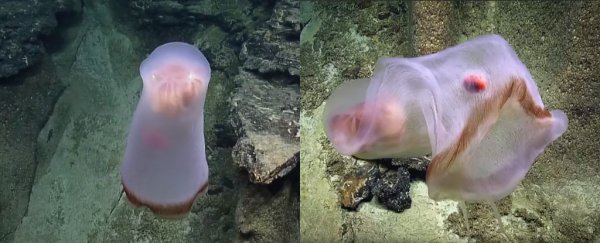When they started to film, scientists on board the exploration vessel Nautilus could barely contain themselves. Way out in the Pacific Ocean, over 750 metres deep (2,500 feet), their remotely operated vehicle had stumbled upon one of the spookiest creatures they'd ever seen.
At first, as they watched the dancing ghost-like entity, there were only questions: What is that? What are we looking at? What's that red structure inside? What is even going on there? What is it thinking? What are we thinking?
Even as they chattered excitedly, the creature changed shape, morphing in and out of recognition, shifting from a floating ghost to a silky scarf.
"I feel like it's expanded since we've been watching it," a voice pointed out.
With a feverish curiosity, the team at last settled on an answer. The shape-shifter in front of them had to be a deep-sea jellyfish, likely from the genus Deepstaria, a relative of the mysterious D. enigmatica, a species only seen a handful of times. And this one clearly had a passenger.
An incredible new video, released by the Nautilus expedition, gives us a peek at one of the most mysterious deep-ocean creatures there is - and a glimpse at the bright red crustacean inside of it.
Known as isopods, these red crustaceans are related to deep-sea pillbugs and they've been found in Deepstaria before. The exact relationship between these two creatures is currently unknown, but the isopod is thought to benefit by feeding on the actual jelly or the jellyfish's food. It's also, in all likelihood a good place to hide from predators.
In contrast, very little is known about its partner, Deepstaria, or how this friend copes with a resident isopod. With so few examples to go by it's unclear what these jellyfish eat, how they reproduce, and even how deep in the ocean they can survive.
Unlike other jellyfish, Deepstaria lack stinging tentacles. Instead, scientists think these creatures filter feed by opening and closing their bag-like bells to trap their prey. How they ultimately digest that prey or distribute it to the rest of their body, however, is still up for debate, although there are a few current theories.
"The geometric mesh pattern is an intricate network of canals that lead back to its stomach at the top of the bell," explains a caption from Nautilus.
"As the jelly can reach a large size when inflated, these channels help distribute nutrients across the entire expanse."
When even the experts are left gobsmacked, you know you're looking at something pretty darn special.
